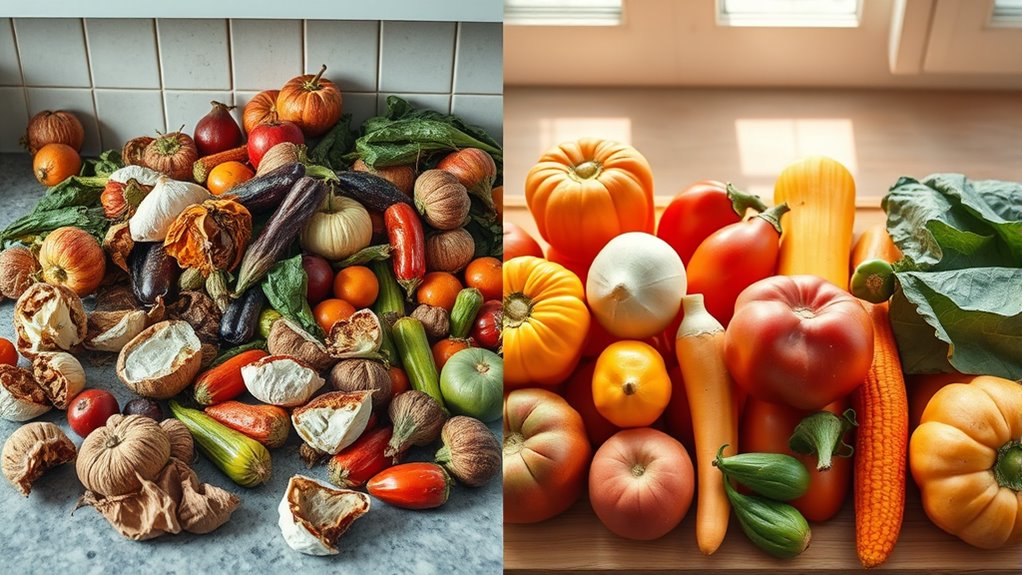Food loss happens before food reaches your plate, often during farming, storage, and transportation. Food waste occurs after it reaches stores or your home, when edible food is thrown away due to over-purchasing, confusing labels, or appearance standards. Understanding how these are caused by supply chain issues and consumer habits can help you make better choices. Keep exploring to learn how solutions can reduce both food waste and loss, saving resources and fighting hunger.
Key Takeaways
- Food loss occurs before reaching consumers, mainly during production, harvesting, storage, and transportation; food waste happens at retail and consumer levels.
- Loss is caused by supply chain inefficiencies, spoilage, pests, and improper handling; waste results from over-purchasing, aesthetic standards, and expiration confusion.
- Reducing food loss conserves resources like water, energy, and land, and prevents environmental impacts such as greenhouse gas emissions.
- Food waste contributes to economic losses, increased landfill pollution, and social issues like food insecurity and inequality.
- Strategies include improving infrastructure, better inventory management, consumer education, and clearer food labeling to minimize both loss and waste.
Defining Food Loss and Food Waste
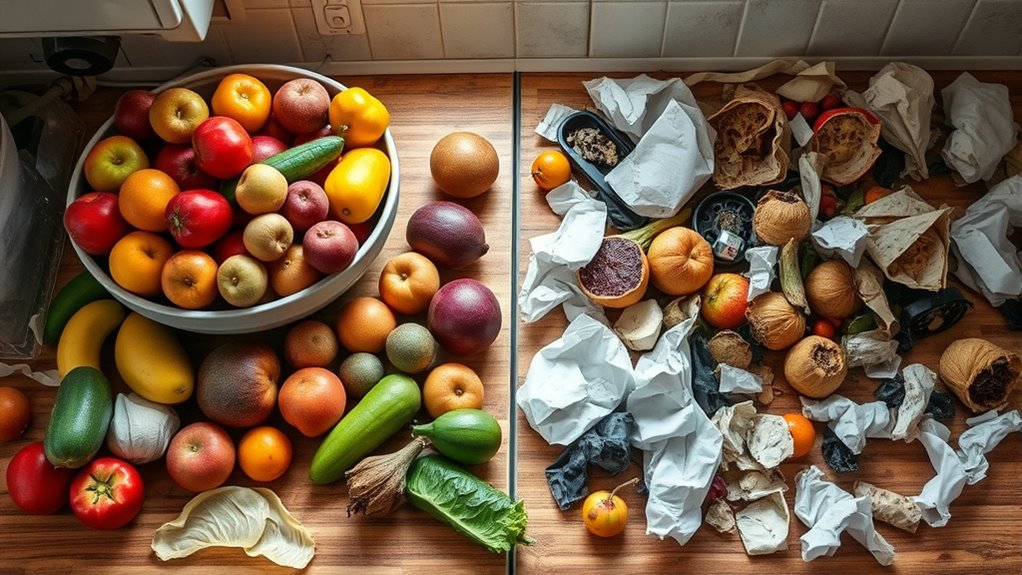
Understanding the difference between food loss and food waste is essential for addressing global food security and sustainability. Food loss happens before food reaches consumers, mainly during production, harvesting, storage, and processing. It includes crops that spoil on farms or get damaged during transport. Food waste, on the other hand, occurs at the retail and consumer level when edible food is discarded. This often results from over-purchasing, confusion over expiry dates, or food aesthetics. Recognizing these distinctions helps target solutions more effectively. Reducing food loss involves improving supply chains and storage methods, while minimizing food waste focuses on better consumer habits and retail practices. Automation technology used in supply chain management can significantly reduce food loss by optimizing logistics. By understanding these terms clearly, you can better contribute to efforts that reduce unnecessary food disposal.
Main Stages of Food Loss

Understanding where food loss occurs helps you see the bigger picture. You’ll notice losses happen during harvest, storage, transportation, and even at retail or when consumers discard food. Recognizing these stages allows you to identify opportunities to reduce waste effectively. Additionally, advancements in AI detection methods are helping monitor supply chains more accurately, which can contribute to minimizing food loss.
Harvest and Collection Losses
Harvest and collection losses occur early in the food supply chain when crops are damaged, improperly handled, or left uncollected. You might see this happen if machinery mishandles produce, leading to bruising or breakage. Poor timing during harvest can result in crops overripening or rotting before gathering. Weather conditions, like rain or storms, can spoil crops before they’re picked. Additionally, farmers may not have enough labor or resources to harvest everything, leaving some crops behind. Improper handling during collection can cause contamination or spoilage. These losses are often unintentional but have a significant impact on food availability. Addressing issues such as energy-efficient models and better handling practices can help reduce early-stage waste and ensure more food reaches markets and consumers.
Storage and Transportation Issues
Storage and transportation issues are major points where food loss occurs after harvest, often due to inadequate facilities or handling practices. When food isn’t stored properly, it becomes vulnerable to spoilage, pests, or mold. You might lack refrigeration or proper packaging, which accelerates deterioration. During transportation, rough handling or delays can damage fragile produce or cause spoilage due to temperature fluctuations. Insufficient cold chain infrastructure means perishable foods spoil before reaching markets, especially in developing regions. Poor logistics planning can lead to delays, exposure to harsh conditions, or overcrowding in transit vehicles. Additionally, implementing proper storage techniques can significantly reduce spoilage and extend the shelf life of perishable foods. These issues heighten the risk of food loss, making it harder for food to reach consumers in good condition. Addressing storage and transportation challenges is vital to reducing food waste and ensuring food reaches its final destination efficiently.
Retail and Consumer Waste
Once food has successfully reached markets and stores, the journey doesn’t end—yet it’s often where significant waste occurs. Retailers and consumers play a major role in this stage. Retail stores may discard produce due to appearance standards, overstocking, or nearing expiration dates. As a consumer, your choices impact waste through behaviors like purchasing excess, misjudging freshness, or not storing food properly. To reduce waste, focus on these key actions:
- Plan meals carefully to avoid impulse buys and over-purchasing.
- Understand date labels to prevent unnecessary disposal of still-edible food.
- Properly store perishable items to extend their freshness and usability.
- Awareness of food waste management practices can help improve disposal methods and reduce environmental impact.
Common Causes of Food Loss

You often see food loss caused by supply chain inefficiencies, where delays and poor logistics lead to spoilage. Harvesting and storage issues also play a big role, as improper handling or inadequate facilities can ruin crops before they reach consumers. Addressing these causes is vital to reducing overall food waste. Implementing decor ideas that promote better organization and storage solutions can also help minimize spoilage.
Supply Chain Inefficiencies
Supply chain inefficiencies are a major cause of food loss, often stemming from poor coordination, delays, and inadequate transportation. When products aren’t moved efficiently, food spoils before reaching consumers. Key issues include:
- Poor Inventory Management: Overstocking or understocking leads to waste, as surplus food perishes or shortages cause quality declines.
- Inadequate Transportation: Insufficient refrigeration or improper handling damages perishable items, increasing spoilage during transit.
- Lack of Real-time Tracking: Without real-time data, delays go unnoticed, and products sit too long, risking spoilage or quality loss.
- Limited understanding of Mother Baby Kids safety standards can also contribute to mishandling and waste.
Addressing these inefficiencies can markedly reduce food loss by ensuring timely, proper handling and movement of perishable goods through the supply chain.
Harvesting and Storage Issues
Harvesting and storage practices considerably contribute to food loss, often due to delays or improper handling that cause spoilage or damage before the food even reaches consumers. If crops aren’t harvested at the right time, they can become overripe or damaged, reducing quality and edibility. Poor storage conditions, like inadequate temperature control, high humidity, or rough handling, accelerate spoilage and decay. For example, fruits and vegetables are highly perishable and require careful handling to prevent bruising or mold growth. Lack of proper infrastructure, such as cooled storage facilities, leads to significant losses, especially in developing regions. Additionally, harvesting techniques play a crucial role in minimizing damage and spoilage during collection. By improving harvesting techniques and investing in better storage solutions, you can drastically reduce food waste at this early stage, ensuring more food reaches markets and consumers in good condition.
Key Factors Behind Food Waste
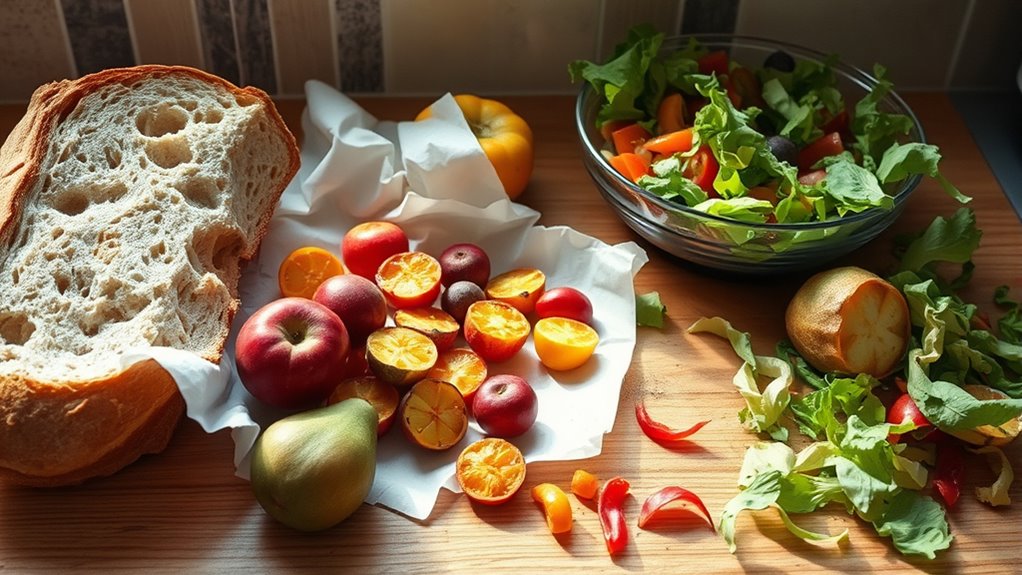
Several key factors contribute to food waste, often stemming from inefficiencies in distribution, purchasing habits, and consumer behavior. First, over-purchasing leads you to buy more than you need, resulting in unused food that eventually spoils. Second, confusing date labels like “sell by” or “use by” cause you to discard food prematurely, even when still safe to eat. Third, aesthetic standards influence retailers and consumers to reject perfectly edible produce simply for looking imperfect. Additionally, misconceptions about food safety can lead to unnecessary waste, as many people discard food out of an abundance of caution. These issues create surplus food that goes uneaten, increasing waste. Addressing these factors requires better planning, clearer labeling, and changing perceptions about food appearance. By understanding these root causes, you can make smarter choices and help reduce overall food waste.
Environmental Impacts of Food Loss

Food loss not only wastes resources but also considerably impacts the environment. When food is discarded prematurely or spoiled, it often ends up in landfills where it decomposes anaerobically, releasing methane—a potent greenhouse gas that accelerates climate change. Additionally, the production of lost food consumes vast amounts of water, energy, and land. These resources are wasted along with the food, leading to environmental degradation and increased carbon footprint. Transporting, processing, and storing food also contribute to pollution and greenhouse gas emissions, especially when food is lost at early stages. By reducing food loss, you help lower these environmental pressures, conserve natural resources, and decrease harmful emissions, making a significant positive impact on the planet’s health. Food waste reduction strategies are essential for creating a more sustainable food system.
Economic Consequences of Food Waste
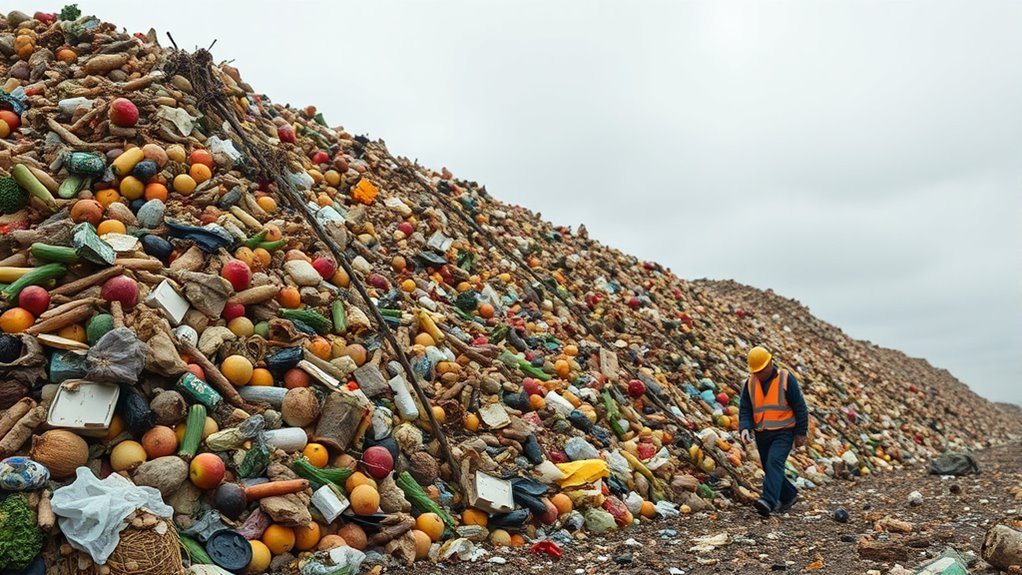
When food goes to waste, you’re also losing valuable resources like water, energy, and labor that went into producing it. This waste drives up costs for producers and consumers, affecting market prices overall. Understanding these economic impacts helps you see how food waste harms both the economy and your wallet.
Wasted Resources Cost
The economic impact of food waste is staggering, as valuable resources are lost every time food is discarded. When food goes to waste, you also waste the resources used to produce it, such as water, energy, and labor. This results in significant costs that ripple through the economy. Specifically:
- Water: You waste approximately 2500 liters of water for every kilogram of food discarded, which strains freshwater supplies.
- Energy: The energy used in farming, transportation, and storage is lost, adding up to billions in unnecessary expenses annually.
- Labor and Inputs: The effort of farmers, workers, and resources like fertilizers go unused, representing lost investments and increased costs for producers.
These wasted resources mean higher costs for society, affecting food prices and economic stability.
Market Price Impact
Have you ever considered how food waste directly influences market prices? When large amounts of food go to waste, it signals an oversupply that can lower prices temporarily. However, persistent waste also affects producers, who may struggle to cover costs if prices drop too much. Conversely, waste can lead to increased costs in transportation, storage, and disposal, which can push prices higher overall. This imbalance distorts the natural supply and demand, making markets unpredictable. Consumers might see lower prices for some products but face higher prices elsewhere due to the inefficiencies caused by waste. Ultimately, food waste creates economic ripple effects that destabilize markets, affect farmers’ incomes, and influence what you pay at the grocery store.
Social Implications for Food Security
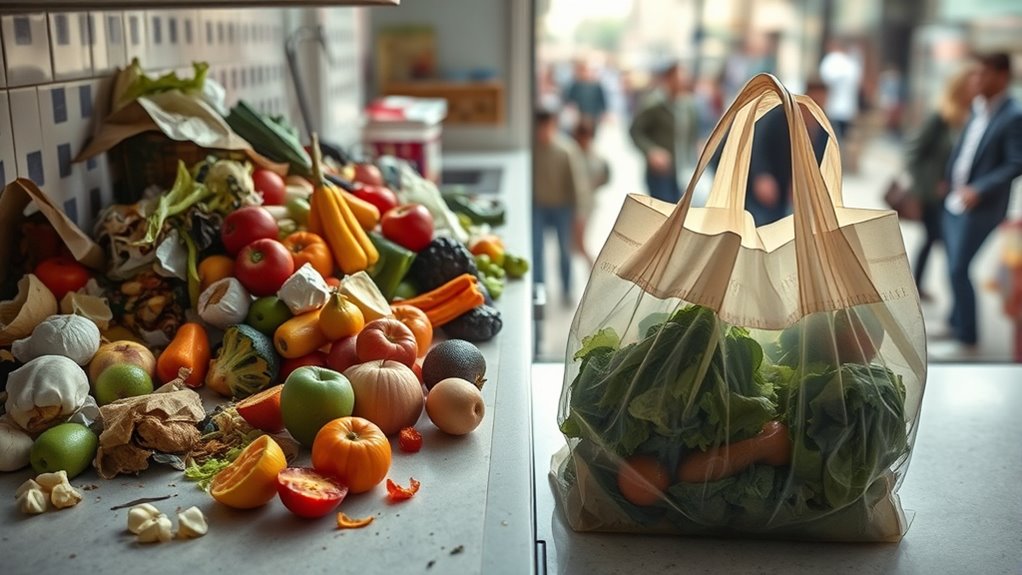
Food security hinges on the effective management of food resources, yet food waste and loss threaten to undermine efforts to guarantee everyone has enough to eat. When food is wasted or lost, it worsens inequality, making it harder for vulnerable populations to access sufficient nutrition. This results in social issues such as increased hunger, poverty, and social unrest. To address these challenges, consider:
- How food waste exacerbates hunger in low-income communities.
- The impact of resource misallocation on social equity.
- The importance of responsible consumption and redistribution programs.
Strategies to Reduce Food Loss
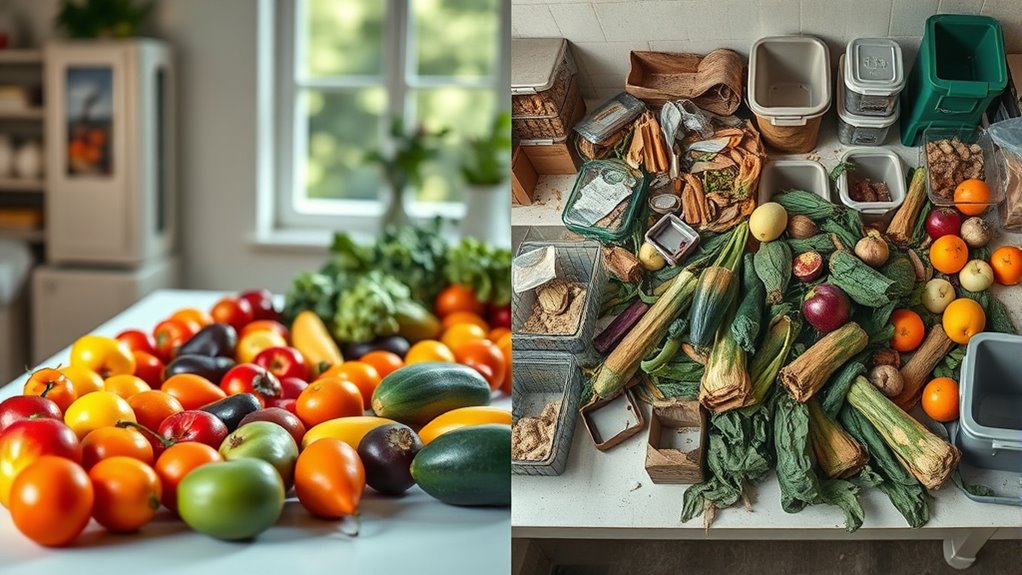
Addressing food security requires more than just reducing waste at the consumer level; it involves implementing effective strategies to minimize food loss throughout the supply chain. You can support better storage techniques that prevent spoilage, such as improved refrigeration and packaging. Investing in infrastructure like transportation and storage facilities helps reduce losses during transit and handling. Encouraging farmers and suppliers to adopt better harvesting practices ensures produce remains viable longer. Implementing inventory management systems allows businesses to track stock accurately, reducing overproduction and expiration. Policy measures, like incentives for loss-reduction investments and stricter quality standards, can motivate stakeholders to prioritize minimizing losses. By focusing on these strategies, you help ensure more food reaches those who need it, making the entire system more efficient and sustainable.
Approaches to Minimize Food Waste
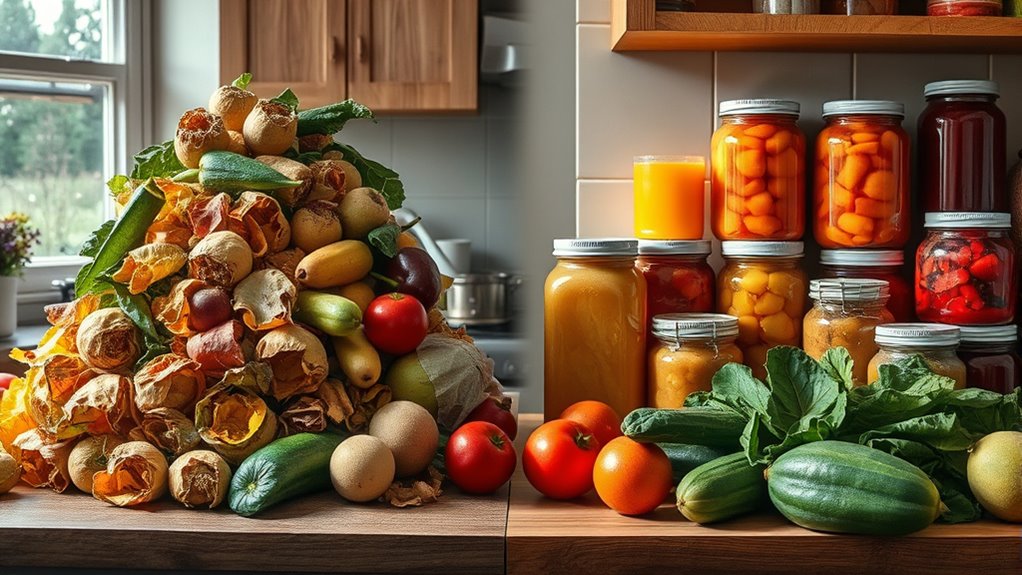
Implementing practical approaches to minimize food waste can substantially improve resource efficiency and reduce environmental impact. First, you can plan meals carefully, buying only what you need to avoid excess. Second, proper storage techniques keep perishables fresh longer, reducing spoilage. Third, using leftovers creatively prevents discarded food and saves money. Additionally, adopting portion control helps prevent over-serving, while donating surplus food ensures it reaches those in need. Investing in better inventory management, like tracking expiration dates, reduces unnecessary disposal. Educating yourself about food labels and storage best practices also plays a vital role. These strategies empower you to cut waste at its source, making a significant difference in conserving resources and limiting environmental harm.
How Consumers Can Make a Difference
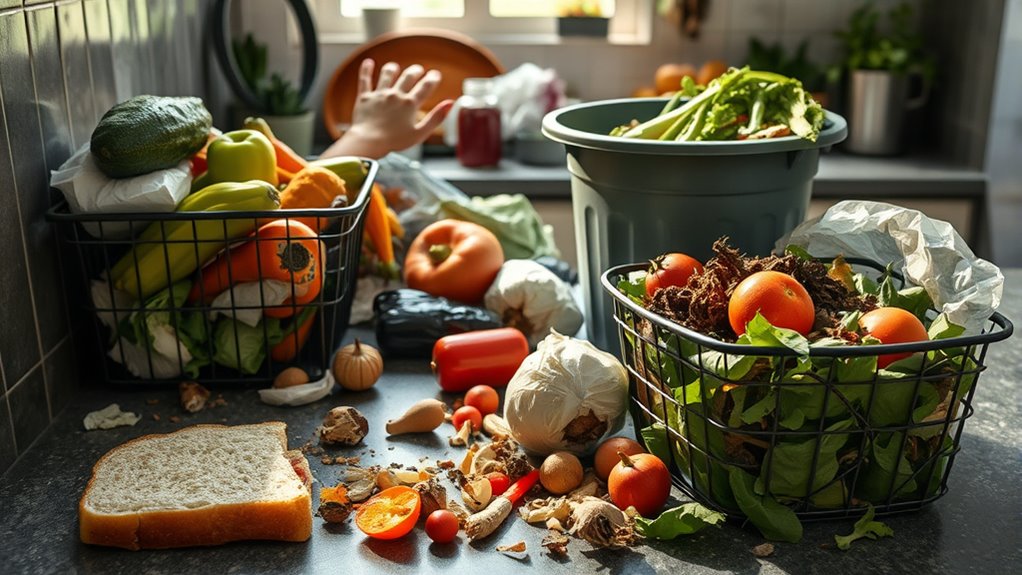
Consumers play a crucial role in reducing food waste by making informed choices and adopting mindful habits. You can plan meals, shop with a list, and buy only what you need. Proper storage helps food last longer, preventing spoilage. Being creative with leftovers reduces waste, and understanding expiration labels ensures safety without discarding edible food. Consider the impact of your choices on the environment and economy. Here’s a quick visual guide:
| Action | Benefit | Tips |
|---|---|---|
| Shop mindfully | Less impulse buying | Stick to shopping lists |
| Store properly | Food lasts longer | Use airtight containers |
| Use leftovers | Reduces waste | Create new meals from extras |
| Read labels carefully | Avoid discarding safe food | Know the difference between “sell by” and “use by” |
Your choices directly influence food waste reduction.
Frequently Asked Questions
How Do Food Loss and Waste Differ in Global Statistics?
You might wonder how food loss and waste differ in global stats. Food loss typically occurs earlier in the supply chain, like during production or storage, often due to issues like pests or inadequate infrastructure. Food waste happens later, mainly at the retail or consumer level, when edible food is discarded. Understanding this distinction helps target efforts effectively, reducing overall food insecurity and environmental impact worldwide.
What Role Do Governments Play in Reducing Food Loss and Waste?
Governments play a vital role in reducing food loss and waste by creating policies that promote sustainable practices, funding programs for food redistribution, and setting waste reduction targets. You can support these efforts by advocating for stricter regulations on food labeling and expiration dates. Additionally, governments can invest in infrastructure like better storage facilities and transportation, making it easier for food to reach consumers rather than being discarded.
How Do Cultural Practices Influence Food Waste Behaviors?
You see, cultural practices greatly influence your food waste behaviors. For instance, in some cultures, there’s a tradition of over-preparing food for celebrations, leading to excess waste. In others, valuing leftovers encourages saving rather than discarding food. Your habits, shaped by cultural norms, determine how much food you throw away. Recognizing these influences helps you make mindful choices, reducing waste and respecting your community’s traditions.
Are There Innovative Technologies to Track Food Loss Effectively?
Did you know that over 40% of food loss occurs during production and handling? You can leverage innovative technologies like IoT sensors and AI-powered analytics to track food loss effectively. These tools monitor storage conditions, predict spoilage, and identify inefficiencies in real-time. By adopting such technologies, you can reduce waste, improve supply chain management, and contribute to a more sustainable food system.
How Can Businesses Improve Supply Chain Efficiency to Reduce Loss?
You can enhance supply chain efficiency by adopting real-time tracking systems, which help identify bottlenecks and prevent spoilage. Implementing better inventory management and demand forecasting reduces overproduction and excess stock. Collaborating closely with suppliers ensures timely deliveries and minimizes delays. Additionally, investing in temperature-controlled logistics preserves product quality. These strategies allow you to cut down on food loss, save costs, and improve overall sustainability in your supply chain.
Conclusion
By staying mindful of how you handle food, you can help turn the tide on waste and loss. Small changes—like planning meals or saving leftovers—create a gentle ripple of impact. Every mindful choice you make helps nurture a more sustainable world, where resources are valued and shared. Together, we can embrace a future where food’s journey from farm to table is smoother, kinder, and more respectful to our planet and its people.
